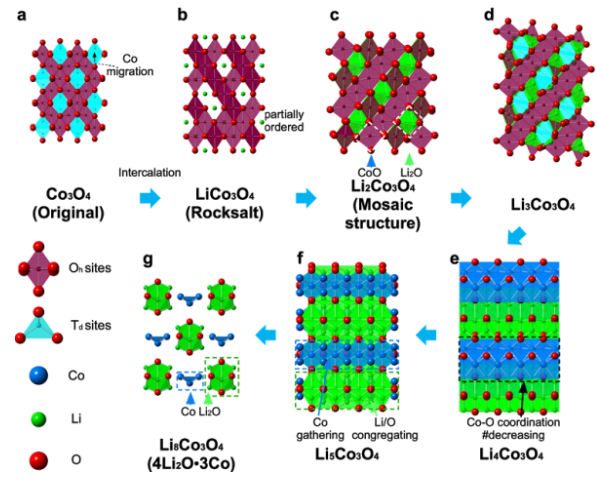Non-equilibrium phenomena in electrochemistry
Lithium ion batteries (LIB) have become a widely-used technology since their commercialization in the 1990’s. However, the current materials are limited in terms of capacity and seeking new, high-capacity reactions has drawn significant attention from the electrochemical energy storage field. Conversion-type materials like transition metal oxides exhibit the possibility to take advantage of all the valence states of the TM (e.g. ) and can thus achieve much higher capacity compared to the intercalation-type materials (e.g. ). However, the conversion-type electrodes, suffer from drawbacks such as huge volumetric expansion, inadequate reversibility, and large voltage hysteresis which have been hindering their practical applications. Thus, in order to push these materials and reactions towards real practical use, there is a large need to obtain a thorough understanding of the conversion reaction mechanisms. Different hypotheses have been suggested as discussed in the manuscript, but some critical issues like the origin of the large hysteresis during charge/discharge of these materials is still not well-understood. We design and utilize a novel computational mechanistic approach (NEPS) that provides, for the first time, a detailed explanation of the hysteresis and non-equilibrium reaction pathways associated with these conversion-type electrodes.

Figure 7. Structures of the non-equilibrium phases on the convex hull and the corresponding phase evolution.
At the beginning of the lithiation, both inserted Li and Co ions from the Td sites tend to occupy the empty Oh sites forming . Furthermore, it is observed that the oxygen fcc array starts to be distorted. In , the - coordination numbers are decreasing, followed by the / congregating and gathering. Lastly, we observe the formation of and clusters, i.e. a strong tendency to phase separate into ground-state phases at that composition. [Ref. 2]
Representative Publications
- H. Liu, Q. Li, Z. Yao, L. Li, Y. Li, C. Wolverton, M. C. Hersam, J. Wu, V. P. Dravid, Origin of Fracture-resistance to Large Volume Change in Cu-substituted Co3O4 Electrode, Advanced Materials, 1704851, 2017.
- Z. Yao, S. Kim, M. Aykol, Q. Li, J. Wu, J. He, C. Wolverton. Revealing the Conversion Mechanism of Transition Metal Oxide Electrodes during Lithiation from First Principles, Chemistry of Materials 29(21), 9011-9022 (2017).
- Q. Li†, Z. Yao†, J. Wu†, S. Mitra, S. Hao, T. S. Sahu, Y. Li, C. Wolverton, and V. P. Dravid, Intermediate Phases in Sodium Intercalation into MoS2 Nanosheets and Its Implications for Sodium-Ion Battery, Nano Energy 38, 342-349 (2017).
- Q. Li†, J. Wu†, Z. Yao†, M. M. Thackeray, C. Wolverton, V. P. Dravid, Dynamic Imaging of Metastable Reaction Pathways in Lithiated Metal Oxide Electrodes, Nano Energy 44, 15-22 (2018).
- M. Amsler, Z. Yao, C. Wolverton. Cubine, A Quasi 2-dimensional Copper-bismuth Nano Sheet, Chemistry of Materials 29(22), 9819-9828 (2017).
- K. He, Z. Yao, S. Hwang, N. Li, K. Sun, H. Gan, Y. Du, H. Zhang, C. Wolverton, D Su. Kinetically-Driven Phase Transformation during Lithiation in Copper Sulfide Nanoflakes, Nano Letters 17(9), 5726-5733 (2017).
- S. Hwang, Z. Yao, L. Zhang, M. Fu, K. He, L. Mai, C. Wolverton, D. Su, Multi-step Lithiation of Tin Sulfide: An Investigation using In-Situ Electron Microscopy, ACS Nano, 12(4), 3638-3645 (2018).
- Q. Li, Y. Xu, Z. Yao, J. Kang, X. Liu, C. Wolverton, M. Hersam, J. Wu, V. Dravid. Revealing the effects of electrode crystallographic orientation on battery electrochemistry via the anisotropic lithiation and sodiation of ReS2 , ACS Nano, 2018, In press.